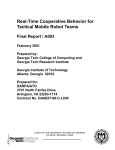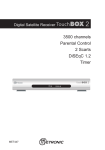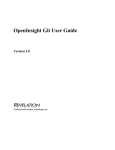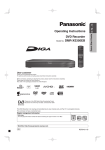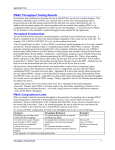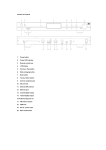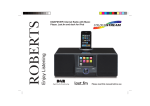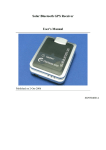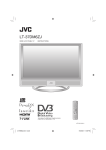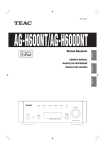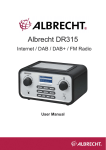Download Thomson DHD4000
Transcript
3573160A00 DHD4000 CVR2.qxd 11/02/2004 09:59 Page 1 Model Contents DHD 4000 T H O M S O N S a l e s U K L td 1 Introduction 19 Archiving Recordings 2 Safety Information 20 Buffering 3 Accessories 20 Changing your PIN 3 Remote Control Handset 21 Tuning your DVR 5 Connections 21 Favourite Channels 8 Basic Operation 22 Features Setup Language selection TV setup options Other features Turning on and off and changing channels 3 0 To w e r Vi e w - K i n g s H i l l 9 We s t M a l l i n g - K e n t M E 1 9 4 N Q Using the Menus England 10 Using the Quick Guide 25 Channel Listings h t t p : / / w w w. t h o m s o n - e u r o p e . c o m 11 Using the 7-Day TV Guide 26 Troubleshooting 12 Making recordings 14 Using the Calendar 15 Working with Timers Adding a new timer recording event manually Removing a timer recording event User Manual 16 Record History Watching recordings Deleting recordings Searching for a scene within a recording 18 Technical information menu Factory reset Reception problems General problems 29 Technical Specifications 29 Messages 29 Upgrading your DVR 30 Extra Information Rear panel connections Front panel indicators and buttons Special remote control features Making Space Scheduling recordings for deletion Reducing the size of a stored recording 31 Index Dealer's address DHD 4000 You can contact THOMSON by dialing : 01788 541970 (All calls are charged at Standard Rates) 3573160A00 © Copyright THOMSON 2003 i STB Sets the remote control unit to STB mode and turns your DVR On, enabling you to control your DVR. DVD / TV Sets the remote control unit to DVD or TV mode, enabling you to control some functions of your Thomson DVD player or TV set. 09:59 Page 2 Turns your DVR (or TV/DVD) On and Off. Press twice for Thomson system power Off. c MENU Displays the DVR main menu. EXIT Removes menu or other information displayed on screen. ARROW KEYS Move the select box around the menus to highlight the option you want. Also allows viewing of schedule information, use Up/Down to choose the programme and Left/Right to choose the time. NUMBER KEYS For selecting channel numbers or entering information into menus. AV Press to watch analogue pictures from your TV set. REV Fast backward search. PLAY Play at normal speed. REC To make an instant recording of the current channel. REPLAY To jump back 30 seconds in the TV programme being watched. LIVE Immediately return to real time if you have been watching a time shifted programme. Safety information Mains connection This receiver is suitable for use on A.C. mains supply, 220-240 V - 50 Hz only. It must not be connected to D.C. mains. Note: The mains lead of the receiver is fitted with a moulded plug. If the mains sockets are not compatible or if for any reason the plug is removed please follow the directions below. The moulded plug cannot be rewired and if removed must be disposed of safely. Remove the fuse to make it safer. Do NOT under any circumstances plug the severed plug into any mains socket as this could result in an electric shock. PR Adjusts the current TV channel. If favourites are programmed this order is followed. a Turn on/off sound. Location B GUIDE Displays the TV programme guides. Adjusts the TV sound level. (Only on a Thomson TV set) ii 11/02/2004 OK Chooses the option you have highlighted or confirms your choice. Also activates Quickfind for fast channel selection. TEXT Enter / Exit teletext services. Important! If the plug is removed, rewire new plug as follows: The wires in the mains plug are coloured in accordance with the following code: BLUE - NEUTRAL BROWN - LIVE As the colours of the wires in the mains lead of this apparatus may not correspond with the coloured markings identifying the terminals in your plug, proceed as follows: BLUE wire to the terminal coded N (Neutral) or coloured black. BROWN wire to the terminal coded L (Live) or coloured red. Do NOT make any connection to the terminal in the plug which is marked by the letter E or by the safety symbol l or coloured green and yellow. 7 cm E 3A L N BLUE BROWN T I G L I D 10 cm A A fused plug must be fitted with a 3A fuse approved by ASTA or BSI to BS 1362 and fuse covers must always be securely replaced. If the fuse blows, check the mains cable for damage or call a qualified technician. Do not try to bridge the fuse or increase its rating! 10 cm 3573160A00 DHD4000 CVR2.qxd 10 cm COLOURED KEYS Use to select the corresponding colour option shown on screen. ! 3A 3A The OFF button B on the remote control and the receiver does not completely disconnect the unit from the mains supply, but switches operating power on and off. Your guarantee WIDE Choose viewing mode for widescreen programmes. FWD Fast forward search. STOP Stop recording or playback. Dear Customer, PAUSE / FRAME ADVANCE Pause playback, or instant pause for a live broadcast. 30 minutes of time shifted recording available, press PLAY to resume watching. This guarantee does not apply to any of the following: 1. Damage caused by accidents including, but not limited to, lightning, fire, water; 2. Transport costs between the home and place of service and other costs and risks of transport relating directly or indirectly to this guarantee; 3. Damage to the product resulting from neglect, misuse, including but not limited to, failure to use, repair and/or install the product for its normal domestic purposes and/or in accordance with the operating instructions on its proper installation and use; 4. Modifications, adaptations and alterations of the product to operate in a country other than that for which it was originally designed and manufactured, or any damage resulting from such modifications; These statements do not affect your statutory rights as a consumer under applicable national legislation in force, nor your consumer’s rights against the dealer from whom you bought the product. If you need service, whether or not under guarantee, please approach the dealer who sold you the product. Thank you for purchasing this THOMSON product and for your confidence in our company. This product meets applicable safety requirements and has undergone stringent testing during manufacture. However, should there occur a defect, the product or its defective part(s) (excluding accessories and consumables) will be repaired free of charge (labor and parts) or, at THOMSON discretion, exchanged for a similar item, provided that it has been returned within 12 (twelve) months from the date of original purchase (date of receipt), is defective in materials and/or workmanship and has been bought in any of the following countries: F, I, E, P, GB, IRL, D, CH, A, B, L, NL (Territory) or in a Duty-free shop in the named countries. This guarantee will be granted only upon presentation of the original invoice or cash receipt, indicating the date of purchase and dealer’s name. The benefits of this guarantee may be refused if the invoice, cash receipt or guarantee card has been altered in any way, deleted or made illegible after the original purchase. SUBTITLES Turns on/off digital subtitles. : In your own interest we advise you to read the instruction booklet for your THOMSON product carefully before contacting your dealer or service center. Jump forwards to the next scene in a recording. 9 Jump backwards to the previous scene in a recording. If you need service while in a country (within the named Territory) other than the one where you bought your product, please contact the nearest THOMSON InfoCenter. iii Should you have any questions which your dealer is unable to answer, please contact: THOMSON InfoCenter (UK,IRL) THOMSON Sales UK Ltd., 30 Tower View Kings Hill West Malling Kent ME19 4NQ tel. 44 (0) 173 252 0920 fax. 44 (0) 173 252 0921 http://www.thomson-europe.com 3573160A00 DHD4000 UM2.qxd 09/02/2004 13:16 Page 1 Getting started Introduction Congratulations on your choice of this state-of-the-art Free to View Digital Video Recorder (DVR). We hope you will enjoy all the new features this technology brings to your home for many years. Your DVR is going to revolutionise the way you watch TV. You can interrupt the programme you are watching, for example while you answer the phone (maximum pause time is 30mins) and then resume watching where you left off. You can also pause two different channels at the same time (recording permitting). Delayed viewing, fast-forward and rewind functions allow you to play and replay the most interesting sequences without having to worry about the rest of the programme which is still being recorded. These features could make you lose track of time, but fortunately the L I V E key brings you back to the present instantly. You can also go back to delayed viewing with the R E V key, as easily as if you were rewinding a video cassette. As soon as you start watching TV, your DVR automatically records everything you watch. It saves the last 30 minutes of the channel currently being watched until it is switched off by pressing the B key. Your dealer should have checked your postcode for reception, but the availability of Digital Signals does depend on the transmitter(s) available to your receiving aerial. If you have any doubt about this availability, please contact your dealer, or try one of the following :• Text your postcode to 83331 (standard rates apply) • Visit the websites www.freeview.co.uk or www.dtg.org.uk/consumer • Call FREEVIEW on 08708 809980 If you experience reception problems, check page 27 for some suggestions or contact our aerial helpline on 0800 5428265 L NupOdTaEtes: oTvheristhperoadiur.cTthise ambalenutfoacetvuorlevre,reasseravecsonthseeqruigehntcetoitpbroenceeefidtstofraonmy ssooffttwwaarree update that it would consider appropriate in order to improve the functionality of the product, without degrading the quality level. See page 29 for details. 1 3573160A00 DHD4000 UM2.qxd 09/02/2004 13:16 Page 2 Getting started Safety information In order that you may enjoy this product for a long time it is important that you observe the following points when installing and operating your receiver ● This receiver is intended for the reception of TV picture and sound signals. Any other application is expressly prohibited. ● Avoid the long-term display of static images, e.g. menus or audio only channels. Use the Radio Blanking feature (see Features Setup on page 23) ● Do not expose the receiver to any moisture. The receiver is intended for use in dry rooms. If you wish to operate it in the open air, make absolutely sure that it is protected against moisture (rain, splashes, etc.). ● Do not place any object filled with water (vases or similar) on the receiver. ● Place the receiver on a flat and hard surface. Do not place any objects (e.g. newspapers) on or under the receiver. ● If placed in an enclosed unit, the all-round distance between the receiver and the sides of the unit must be at least 10cm. Do not allow the vent slots in the sides or underneath to become obstructed. ● Do not place the receiver in the immediate vicinity of a heat source or in direct sunlight as this would prevent appropriate cooling. ● During a thunderstorm it is recommended that you disconnect the receiver from the mains and aerial to prevent damage from lightning strikes. ● Never open the receiver as this will invalidate your guarantee. ● Do not dispose of used batteries in normal waste. Please dispose of them at appropriate collection points. ● If you are not using the receiver for a long time (e.g. Holidays), please switch it off at the mains. This saves energy. Note that any software upgrades take place at night. ● This product has been constructed with the environment in mind. There is a minimum of plastic parts and the packaging is largely made from recycled paper. It is also disassembly-friendly allowing for easy recycling at the end of its life. CLEANING - Dust will collect on the unit and can be removed with dry clean cloth. Do not spray any substance on the unit. 2 3573160A00 DHD4000 UM2.qxd 09/02/2004 13:16 Page 3 Getting started Accessories Y User Manual Quick Guide Guarantee cards Coaxial lead 2 x AAA Batteries Z [ Mains Lead Scart lead Remote Control Remote Control Inserting the batteries u v w Insert the batteries into the handset. Check they are the right way around (see picture). Point the remote control at the DVR and press the S T B button. L If you have a Thomson TV or DVD player, you can operate some of the features of your TV/DVD by pointing the handset at the TV/DVD and pressing the T V or D V D button. The handset will then work the TV or DVD until you press the S T B button again. Important information regarding the batteries Do not mix different types of batteries or new and old batteries. Do not use rechargeable batteries. Do not throw batteries into a fire, do not recharge them. Remove the batteries from the remote control if you are not going to use it for several weeks. Immediately remove any leaking batteries. Take care in doing this, as leaking batteries may cause burns to the skin or other physical injury. • Please respect the environment and prevailing regulations. Before you dispose of batteries ask your dealer whether they are subject to special recycling and if they accept them back. 3 3573160A00 DHD4000 UM2.qxd 09/02/2004 13:17 Page 4 Getting Started Remote Control Using the remote control handset to control your THOMSON television and DVD player The DVR remote control handset is a 3 in 1 device that allows you to control the operation of 3 devices: your DVR, a Thomson TV set or a Thomson DVD player. This page describes the keys that control your TV set and your DVD player if they have the same functions. Controlling a THOMSON TV set TV B a c PR +/AV 0 to 9 MENU EXIT TEXT Note: Sets the remote control unit in TV mode (by pressing once) and enables you then to control your TV set. Switches the TV set on or off Volume control. Switches sound off or on again. Switches channel or selects an AV socket. Selects an AV socket. Keys enter digital values or change channel. Displays main TV set menu. Removes menu or other information displayed on the screen. Access teletext pages. The colour keys enable you to use the teletext function on THOMSON TV sets. Controlling a THOMSON DVD player DVD B PR +/0 to 9 MENU EXIT REV PLAY FWD STOP PAUSE REPLAY 4 Sets the remote control unit in DVD mode (by pressing once) and enables you then to control your DVD player. Switches the DVD player on or off Skips forward or backward a chapter (DVD) or track (CD). To enter information (chapter, track number,...). Displays the DVD disc menu while a disc is being played. Return to the main menu. Fast backward whilst a disc is being played. Plays a disc. Fast forward whilst a disc is being played. Stops a disc playing. Still picture and frame by frame advance. Skip back - to have another look at the last few seconds whilst playing a disc. 3573160A00 DHD4000 UM2.qxd 09/02/2004 13:17 Page 5 Getting started Connections How to connect the aerial and scart cables L R E M E M B E R S A F E T Y F I R S T - A L W A Y S U N P L U G A L L YO U R E Q U I P M E N T F R O M THE MAINS BEFORE MAKING CONNECTIONS TV Aerial TV OUT AV1 EXT1 AUX1 VCR AV1 EXT1 AUX1 IN Aerial Leads Scart Leads u w v OUT VCR Phono Leads TV Optical Lead HI FI IN AUX VIDEO EXT AUX IN L x DIGITAL IN R Follow the steps below referring to the numbered parts on page 3 and the diagram above:X Unplug the antenna cable from your VCR and plug it into the A e r i a l I n socket of your DVR. Y Using the long coaxial cable supplied, link the R F O u t socket on your DVR to the A e r i a l I n socket of your VCR. Your DVR should now be linked first to your aerial, then to your VCR and finally the VCR to the TV. Z Using the scart lead supplied, link the T V S C A R T socket on your DVR to the A V 1 / E X T 1 / A U X 1 socket of your TV. [ Finally, connect the mains lead to the M a i n s I n p u t socket on your DVR and turn on your TV. After a few seconds, the lights on the front will come on and a menu will appear on the TV screen. Please follow the on screen instructions carefully and press O K when you are ready. The DVR will now tune in all your available digital TV stations. N O T E : The 7 day programme guide will not have information immediately as this has to be received overnight. 5 3573160A00 DHD4000 UM2.qxd 09/02/2004 13:17 Page 6 Getting started More Connections The diagram on page 5 shows a connection method that includes a VCR and a Hi-Fi or AV-Amplifier with an optical input. The supplied connections allow rapid connections to the TV only, in order to get you going as quickly as possible. But should you wish to adopt the more advanced connections shown in the diagrams on page 7, please purchase additional leads as explained below. 1 - Archiving off the DVR onto a VCR or other recorder. Use a scart lead to link the V C R S C A R T socket on your DVR to the A V 1 / E X T 1 / A U X 1 socket of your VCR. This connection will allow you to archive to a permanent media. If your VCR supports auto-start recording, then the DVR will control the VCR automatically. 2 - Connection to a Hi-Fi system. Use a pair of stereo coaxial phono leads to connect the L / R A U D I O O U T socket on your DVR to the L / R A U D I O IN on your Hi-Fi unit. This will allow you to hear higher quality sound through your Hi-Fi. N O T E : Audio sockets are generally identified by colour. White for Left and Red for Right. 3 - Coaxial or Optical connection to an Audio Visual Amplifier. To get even better sound from your DVR, use a digital audio phono lead to connect from the D I G I T A L A U D I O O U T socket on your DVR to the D I G I T A L A U D I O IN on your AV amplifier. For the very best sound connection, use an optical “Toslink” cable to connect from the D I G I T A L A U D I O O U T socket on your DVR to the D I G I T A L A U D I O IN on your AV amplifier. N O T E : In most cases these two types of connection give similar results; the only difference lies in the type of cable being used. The coaxial cable is the cheaper of the two, but can suffer from external interference from other household devices. The optical lead does not suffer from this type of problem. 4 - S-Video connection to a TV, Plasma Display or Projector The scart connection to a TV provides the best picture as RGB (Red,Green,Blue separately), but some types of display device don’t have a scart socket. In this case, either an adaptor should be purchased, or connect an S-Video lead from the S - V I D E O O U T on your DVR to the S - V I D E O I N on your TV, Plasma display or projector. This will also give a high quality picture, but you must make a separate audio connection, as the cable doesn’t carry sound. 6 3573160A00 DHD4000 UM2.qxd 09/02/2004 13:17 Page 7 Getting started Advanced connections Connections for a DVD & VCR with a TV with only one scart socket or one RGB scart socket. VCR must have 2 sockets with RGB pass through. TV Aerial TV DVD Aerial Leads SCART AV EXT AUX OUT VCR Scart Leads IN Phono Leads AV2 EXT2 DECODER AV1 EXT1 AUX1 Optical Lead VCR OUT TV IN AUX VIDEO EXT AUX IN L DIGITAL IN NOTE: 1. The PVR and the VCR must be in standby to watch the DVD. 2. If your TV has 2 scart sockets with RGB input, connect your DVD player directly to your TV. R AV AMPLIFIER Connections for a DVD & VCR with a Plasma (or projector) display. Digital audio connections are not required, but give the best result. PLASMA DISPLAY TV Aerial OUT DVD S-VIDEO VCR AV1 EXT1 AUX1 S-VIDEO RGB IN S-VIDEO R G B CVBS Aerial Leads Scart/SVHS Leads IN Phono Leads Optical Lead OUT TV IN AUX VIDEO EXT AUX IN L VCR DIGITAL IN R AV AMPLIFIER 7 3573160A00 DHD4000 UM2.qxd 09/02/2004 13:17 Page 8 Getting started Basic Operation N T : Before you go any further, are you watching a digital TV picture? L CREHMECEKDYPO: ICheck that your TV aerial is plugged into the DVR A e r i a l I n and press the O K button again. This will make the DVR try tuning again. If it fails again, you will probably need to improve your aerial, please refer to the troubleshooting section on page 26. Turning On and Off To turn on your DVR, press any number key, the S T B key or the B key. The red standby indicator light will go green. To turn off your DVR, press the B key. The standby light will turn red again. The DVR should be left in standby if you want to keep the programme guide updated, but if you are not going to use the DVR for long periods of time you should unplug it to save energy. Changing channels To change channel you press the P R + or P R - buttons. This will step through the channel list one at a time. You can also set a favourite channel list which will allow you to skip between the channels you watch most often. How to set up this list is explained on page 21. Note that the channel numbers are not continuous. These are set by the broadcaster and cannot be changed. If you wish to search for your channel by name, use Quickfind. 1. Press the O K button. 2. Use the arrow keys to move the highlight around the programme names, until the channel you wish to watch is highlighted. (Only some channels are shown inside the box, keep moving left or right to find the rest.) If favourite channels are set, only those chosen will appear in the box. 3. Press the O K button again to change the channel. If you know the channel number you are looking for, enter this using the number keys. With digital TV there can be up to 3 digits in the number. A banner with information about the programme currently showing will appear briefly each time the channel changes. For more details on getting programme information, see page 10 Teletext and interactive services If your chosen channel has Teletext (MHEG) features press the T E X T or coloured keys to access them. To return to normal viewing press T E X T again. Some services offer interactive features, details of these and how to use them will appear on screen as they occur. 8 3573160A00 DHD4000 UM2.qxd 09/02/2004 13:17 Page 9 Using your DVR Using the Menus To set up and work the other facilities of your DVR you will need to get used to operating the menus. Throughout this book, we will use B O L D text when referring to remote control button presses, and I T A L I C text when referring to a particular menu level. You will be using the remote control buttons highlighted and the coloured keys, take a moment to find them now. To use these menus, you must first press the M E N U key which will then display the main menu. Now choose the item (called a sub menu) that you want to look at. You do this by using the U P arrow (U U ), to move the yellow box up the list and the D O W N arrow (V V ) to move it down the list. Once you have highlighted your choice with the yellow box, press the O K button to move to the new menu level. If the DVR states that a PIN number is required (Personal Identification Number), enter this now. The default number is 0 0 0 0 you can find how to change this on page 20. As you learn to use the DVR you will find that the number buttons can take you directly to sub menus without the need for using the arrow buttons. e.g. Use 5 for the fifth item (s e t u p), 1 for the first item (favourites), etc. In each menu, look at the bottom lines of text for more information on which buttons to press. This could be arrow buttons (Y Y or Z ) or the coloured buttons. Finally, when you have finished making adjustments, use the E X I T button to return to the TV picture. You may need to press it more than once, depending on the menu item. L 9 3573160A00 DHD4000 UM2.qxd 09/02/2004 13:17 Page 10 Using your DVR Using the Quick Guide When you are watching TV you can find out what else is on other channels without interrupting your viewing using the TV Quick Guide. This is the small banner that appears at the bottom of the screen during channel changes or when you press an arrow key. Shows the current time and date Shows the channel name Shows the programme duration Shows the programme name and start time Shows short details of the programme The box shows the channel condition:Green - Current, Yellow - Paused, Red - Recording To change the view to show different times during the day use the left and right arrows. To see what’s on another channel use the up and down arrows. If you see a programme you want to watch, press O K . If the programme is on now the DVR will change to it immediately. If it is on later, the DVR will automatically set a programme reminder for you. L 10 N O T E : The 7 day programme guide receives it’s information overnight (about 3am) so if you switch your DVR off overnight the Quick Guide will only show what is on Now or Next. We recommend that you leave the DVR in standby overnight. 3573160A00 DHD4000 UM2.qxd 09/02/2004 13:17 Page 11 Using your DVR Using the 7-Day TV Guide Your DVR has a built in 7-Day programme guide which gives you a fast way of planning your viewing and recording. To access this guide, press the G U I D E button. The programme guide has two different formats. These display programmes by time for a specified channel (as above left) or by channel for a specified time (as above right). Press the G R E E N button to change between the two different modes. Use the up and down arrows to move the box up and down the programme list. Use the left and right arrows to change the time you are looking at or the channel you are looking through. If you wish to limit the number of channels shown in the guide, press the Y E L L O W button. This will then only show the channels you have chosen as favourites. See page 21 for details on favourites. Press Y E L L O W again to restore the full list. When looking through the listings, the small picture does not change allowing you to continue watching the current programme. If you wish to have a preview of a channel that you have selected in the guide, press the P U R P L E button. Press E X I T to return to the current channel. When you highlight a programme, after a few moments a description of the programme will appear in the synopsis box to give you some idea of what the programme is about. Once you have found a programme you wish to see, if it is on now press the O K button and the DVR will change to the new channel immediately. If you wish to be reminded about the programme later on, press the B L U E button. To cancel the reminder, press the B L U E button again. Just before the programme starts, a message will appear on the screen asking if you wish to view the programme, press G R E E N to confirm. If you wish to record the programme, press the R E D button. The details of the recording will be passed onto the recordings manager. See page 12 for details on recordings. L N O T E : Some programmes are marked in the guides with different coloured boxes. Red shows a channel being recorded, Green shows the channel you are currently watching and Yellow shows that a channel has been paused (see buffering on page 20). 11 3573160A00 DHD4000 UM2.qxd 09/02/2004 13:17 Page 12 Using your DVR Making recordings Your DVR has the ability to record two different programmes at the same time, whilst playing back a third! To organise this and ensure you are not disappointed, the DVR has a recording list that allows you to see what is going to be recorded. It also checks for programme clashes and that there is enough room on the hard disc to record the programmes. Making a recording from the 7-day programme guide The following example shows how to add a programme to the record list using the calendar and the 7-day guide. 1. Press M E N U , then 2 to display the calendar. (See page 14 for more details on the calendar function.) 2. Use the Y / Z keys to select the day of the programme you wish to record. Note you can only select white days. If there are no white days, leave your DVR on overnight to receive the listings. 3. Press O K to display the programme guide for the day you have chosen. N O T E : You can also open the programme guide by simply pressing the G U I D E button while watching TV. This will select today and now as the starting point. 4. Using the arrow keys, select the programme you wish to record. (See page 11 for details on using the 7-day programme guide). 3. Press the R E D key. The menu opposite will appear. 4. If you wish to change the start and finish times suggested by the guide, then i) Use the Y / Z keys to select the start or end times. ii) Use V / U to adjust the time, note you can only make the recording longer. 12 3573160A00 DHD4000 UM2.qxd 09/02/2004 13:17 Page 13 Using your DVR Making recordings cont’d 5. When you are happy with the times, press the G R E E N key to add the new item to the record list. (See opposite) 6. Press E X I T to return to the programme guide. 7. Repeat steps 2 to 6 above until you have scheduled all your desired recordings. 8. Press E X I T to return to TV viewing. To view your recordings see the Record History section on page 16. If there is a programme clash or there is insufficient space to complete a recording, a warning message will be displayed. Adjust the start/end times accordingly as in step 4 above, or exit this menu and make space on the DVR to allow more recording to take place. See page 18 for details on making space. N O T E : You can also make an instant recording by simply pressing the R E C button while watching TV. This will automatically take you to step 4 with the current programme selected for recording. On completion of the timer setting, the recording will start immediately. Notes on making recordings • • • • • L • The bar across the bottom of the recording list (see picture above) indicates how much space is available on the hard disk. The dark blue part shows space that is occupied, the yellow part shows space that has been reserved by a timer event and the light blue part shows how much free space you have left. When the hard disk is getting full you can delete, compress or archive recordings to tape. See pages 16, 18 and 19 for details. When two timer events are happening at the same time, if you try to change channel you will see a warning message that the recording will be terminated. You can choose to cancel the recording to make the channel change by pressing R E D . You can view a stored recording or playback a VCR tape even if both timers are operating. When recordings are happening a red light will illuminate on the front of the DVR and the programme details in the programme guides will be marked with a red box. As the TV guide is downloaded during the night, there is a chance that a timer recording may interfere with this process. If this is likely, a warning message will appear. If you choose to continue the recording, you will only lose one day’s information from the guide. 13 3573160A00 DHD4000 UM2.qxd 09/02/2004 13:17 Page 14 Using your DVR Using the Calendar Your DVR has a personal calendar that allows you to manage your diary. You can view TV recording events, enter birthdays, anniversaries and appointments. At the appropriate times, your DVR will display an on screen message to remind you. The days covered by the 7-day guide are shown in white. When you select a day and press O K , you will see the programme info for that day, if available, in the guide. To view the calendar, press the M E N U button, and press 2 , to select the calendar function. • Use the R E D and G R E E N keys to move backwards and forwards through the calendar a month at a time. • Use the arrow keys to select a day in the month. • Press the Y E L L O W key at any time to return to Today. Any record events or reminders are shown on the calendar as coloured dots. A red dot signifies recording events have been set and a blue dot signifies a reminder is set. Record events are managed automatically in the calendar by the recording menus. See page 12. To enter the reminder menu, press the B L U E key. To edit an existing reminder for the chosen day press G R E E N . If no reminders have been set, then enter a new reminder as below, else press Y E L L O W first. 1. Now choose the type of reminder using V / U , Yearly, Monthly, Weekly, Daily or single. 2. Enter a time using the number keys, 0 . . 9 . (24hr clock) 3. Now enter your message. This works the same way as a mobile phone text message by using the number keys 2 to 9 (note the letters above each handset key, e.g. press key 4 twice to get ‘H’). Each time you pause the cursor will move on a step. • To change caps press the Y E L L O W key. • To delete a selected letter press the R E D key. • To enter a space press the 0 key. • To enter punctuation, press the 1 key. • To enter numbers, press the appropriate key repeatedly. • To move backwards and forwards in the text use Y / Z . 4. Once you are happy with the reminder text, press the O K key to store the text or B L U E to cancel the whole reminder. 5. Press E X I T to return to the TV picture. At the appropriate time, the text of your reminder will appear on the TV screen. Press O K to clear the message off the calender or G R E E N to snooze the reminder for a short time. 14 3573160A00 DHD4000 UM2.qxd 09/02/2004 13:17 Page 15 Using your DVR Working with Timers Adding a new timer recording event manually 1. Press M E N U then 3 to display the record list. 2. Press the O K key to start entering a new event. 3. Use the arrow keys, Y / Z , to choose the programme that you wish to record. 4. Press V , then use the number keys, 0 . . 9 , to enter the programme name using the same method as on page 14, step 3. 5. Press V , then use the arrow keys, Y / Z , to enter the date of the recording. 6. Press V , then use the arrow keys, Y / Z , to enter the start time for the recording. 7. Press V , then use the the arrow keys, Y / Z , to enter the stop time or duration of the recording. 8. When all the details are correct, press the G R E E N key to save the event to the list. 9. Verify that the programme times are correct and that there is sufficient space. You have a second chance to modify the start and end times if required. 10. Press the G R E E N key to add the programme to the record list. 11. Press E X I T to return to TV viewing. L If a mistake is made whilst setting a timer event, an error message will be displayed. This may be because you have tried to set too many events to record at the same time or there is an error in the times that you have chosen. There may simply not be enough space to fit the recording. Use the arrow keys to correct the mistake or press E X I T to cancel the event. Removing or changing a timer recording event To 1. 2. 3. 4. remove a previously stored event:Press M E N U then 3 to display the record list. Use the arrow keys, U / V , to select the recording timer you wish to change/remove. Press the R E D key. This will move the item into the top window. If you wish to correct the times use the arrows keys as before. Then to add it back to the record list press G R E E N . 5. If you wish to remove the timer event, skip step 4 above. 6. Press E X I T to return to TV viewing. The timer event is now changed/removed. 15 3573160A00 DHD4000 UM2.qxd 09/02/2004 13:17 Page 16 Using your DVR Record History With about 20 hours worth of recording space available, it is possible to record many programmes. The record history shows a list of all your recordings and allows you to decide what to do with them. You can watch them, delete them, or save them to tape (archiving). Watching recordings 1. Open the record history menu by pressing M E N U then 4 . Shows short details of the recording Shows scenes of the recording. These allow you to search through a recording to watch certain parts. A Snapshot is normally taken every 5 minutes whilst recording. Shows the list of programmes that you have recorded. 2. Since it takes time to retrieve the pictures of the scenes you may wish to skip this stage. Press R E D to skip the process or G R E E N to get the pictures. 3. Use the arrow keys, U / V , to select the recording you wish to view. 4. To view the recording from the start press the O K key. Once playback has started you can use the handset to control playback. - Resume playback - Fast backwards search - Fast forwards search - Pause playback - Stop playback and return to history - Jump backwards a scene - Jump forwards a scene O K - Create a new scene bookmark Deleting recordings When you have finished watching your programme, press S T O P to return to the record history then follow the instructions below from step 3. Alternatively, 1. Open the record history menu by pressing M E N U then 4 . 2. Use the arrow keys, U / V , to select the recording you wish to delete. 3. Press the R E D key, then press the G R E E N key. 4. Press O K . The recording will be deleted immediately and the space made available for recording again. 16 3573160A00 DHD4000 UM2.qxd 09/02/2004 13:17 Page 17 Using your DVR Record History Searching for a scene within a recording Once you have selected the recording you wish to watch, you have the option to search through the programme to find the ‘scene’ that you wish to view from. This is a kind of visual bookmark. 1. Use the arrow keys, Y / Z , to select the scene from which you wish to view. The length of the programme is represented by the bar under the windows. If no bar is present then only 4 scene bookmarks are available. As you move through the bookmarks, the bar will move giving you an indication where you are in the recording. 2. To view the recording from the selected scene press the O K key. 3. If you wish to delete the scene bookmark from the recording, press the R E D key, then press the Y E L L O W key to delete the scene. 17 3573160A00 DHD4000 UM2.qxd 09/02/2004 13:17 Page 18 Using your DVR Making Space As the hard disc begins to fill up, you will need to make space in order to keep recording. You can do this in a number of ways. Either reduce the size of the recording, or schedule it for deletion or archiving later on. Scheduling recordings for deletion 1. Open the schedules menu by pressing M E N U then 4 ., then B L U E 2. Use the arrow keys, U / V , to select the recording you wish to schedule. 3. Press the R E D key to schedule the recording to be deleted. ‘ [ d ] ’ will appear. The recording is not deleted immediately, it is kept until the DVR needs room to make a new recording, then deleted. You stop it being deleted by pressing the R E D key again. N o t e : If you want to delete a recording immediately, see page 16. Reducing the size of a stored recording 1. Open the schedules menu by pressing M E N U then 4 , then B L U E . 2. Use the arrow keys, U / V , to select the recording you wish to schedule. 3. Press the P U R P L E key to select ‘ [ l p ] ’ to allow the DVR to compress the recording to make extra space. This will reduce the picture quality of the recording. You can reduce the size of a recording made in ‘ s p ’ mode but this is a one-way process; once compressed, the recording cannot be decompressed. You can cancel compression so long as the brackets [ ] are still showing. ‘ s p ’ - High Quality, Largest space requirement. ~2Gb used per hour. (Max. 20hrs) ‘ l p ’ - Low Quality, Small space requirement. ~1.5Gb used per hour. (Max. 26hrs) These times are only intended as a rough guide, as the actual space required varies with the type of programme recorded. e.g. A soap can take less room than a football match over the same time period. This ‘bitrate’ is determined by the TV broadcasters. 18 3573160A00 DHD4000 UM2.qxd 09/02/2004 13:17 Page 19 Using your DVR Archiving Recordings If you want to permanently save a recording, you can schedule it to be played out and recorded on a VCR or another device connected to the VCR scart socket. To archive recordings 1. Open the schedules menu by pressing M E N U then 4 ., then B L U E 2. Use the arrow keys, U / V , to select the recording you wish to archive. 3. Press the B L U E key to schedule the recording for archiving; ‘ [ a ] ’ will appear. 4. Press the G R E E N key to select a r c h i v e t i m e. 5. Use the arrow keys, Y / Z , to select the date for the next archiving playout. 6. Use the arrow keys, U / V , to select time. 7. Use Y / Z , to select the time for the next archiving playout. 6. Press G R E E N to store the archiving event or R E D to cancel. L N o t e : If your VCR or other recorder, supports automatic start, then at the archive time the DVR will start the recorder. If not, you MUST set the timer in your VCR to start at the a r c h i v e t i m e and run for the total length of all the recordings you have scheduled for playout. The DVR will then playout all the recordings that you have scheduled, in the order you chose. You can playout archive recordings whenever you like, but remember that you won’t be able to view anything else on your TV. Recording events are unaffected. 19 3573160A00 DHD4000 UM2.qxd 09/02/2004 13:17 Page 20 Using your DVR Buffering When you are watching TV, the DVR automatically ‘buffers’ up to 30 minutes of the channel you are currently watching. This provides for the ‘Live Pause’ features. As the DVR contains two tuners, when there is no timer recording event set, the second tuner can be tuned to another station and allow you to ‘buffer’ two channels at once. 1. Press P A U S E and the current programme will stop. The bar shows how far behind Live TV you are. 2. Choose another channel to watch. Use any of the guides if you wish. 3. Press P A U S E to stop the new selection. If you press 0 , the DVR will automatically ‘swap’ to the other channel and resume playback. If you press 0 again, the DVR will place the current ‘buffered’ channel back on pause and ‘swap’ to the other one, and so on. You can use all the functions for rewind (R R E V ), fast forward (FF W D ) and slow on either channel. When you want to return to live TV again, press the L I V E key. If you wish to jump back 30 seconds in the programme press the R E P L AY button. L N o t e : You can also use this ‘swap’ feature with recordings. Simply place the current channel on P A U S E then select a recording to watch (see page 16). Now you can ‘swap’ between the two ‘buffered’ TV channels and the recording. Changing your PIN Certain features of the DVR require the entry of a Personal Identification Number (PIN). The default number for this is 0 0 0 0 . It is highly recommended that you change this number. To do this follow the steps below. 1. Open the s e t p i n menu by pressing M E N U then 5 , then 5 . 2. Use the number keys to enter the current PIN. 3. Now, use the number keys to enter a new PIN. 4. Finally, Confirm the new PIN by entering it again. Keep your PIN secret, but don’t lose it! 20 3573160A00 DHD4000 UM2.qxd 09/02/2004 13:17 Page 21 Setting up Tuning your DVR When you first plugged in your DVR, it will have tuned in all the available services automatically. However, should you move house or wish to tune in new services as they appear you may need to tune new services in again. 1. Make sure that all the connections have been made as in the diagram on page 5. 2. Open the s c a n f o r c h a n n e l s menu by pressing M E N U then 5 , then 8 . 3. Press the G R E E N key to start tuning. The DVR will now tune in all the available services for your area. All the channels will be stored in the numerical order specified by the various broadcasters. If the tuning process does not find any channels, or only a few, you may need to upgrade your TV aerial. Refer to troubleshooting on page 26. 4. Press the G R E E N key to start watching Digital TV. Favourite Channels After tuning, all the Free-to-View channels are automatically added to the favourites list. This list determines the order in which channels are selected when pressing the P R + / P R - keys. In the example below, when watching ITV1, pressing P R + would select BBC TWO. You can change this list to your own viewing requirements. Channels included as favourites have a tick in the check box. 1. Open the s e l e c t f a v o u r i t e s menu by pressing M E N U then 5 , then 1 . 2. Use the arrow keys, U / V , to choose a channel. 3. Press O K to change the check mark next to the chosen channel. 9 = Favourite 4. Press B L U E to reorder the chosen channel. 5. Use the arrow keys, U / V , to choose the new position for the chosen channel. 6. Press the B L U E key again to store the channel in its new location. 7. Repeat steps 2 to 6 until the list is as required, then press E X I T . If you wish to add all the channels to your favourite list press the G R E E N key. To remove all the channels from the favourite list press the Y E L L O W key. The channel order is now also reflected in the Quick and Programme Guides. 21 3573160A00 DHD4000 UM2.qxd 09/02/2004 13:17 Page 22 Setting up Features Setup Your DVR has many features that you can configure for your particular requirements. The following pages will explain the various features and how to use them. The factory default settings are shown underlined. Language selection 1. Open the languages menu by pressing M E N U then 5 and then 2 . 2. Use the arrow keys, U / V , to select subtitle language or audio language 3. Use the arrow keys, Y / Z , to choose from english, welsh or gaelic. 4. Repeat steps 2 and 3 for subtitles. Default setting is on. 5. Press E X I T to return to TV viewing. TV setup options 1. Open the tv setup menu by pressing M E N U then 5 and then 4 . 2. Use the arrow keys, U / V , to select p i c t u r e f o r m a t. 3. Use the arrow keys, Y / Z , to choose from 4:3 letterbox (black bars top and bottom), 4:3 Centre Cut-Out (full screen, but lost picture on left and right),, 4:3 Full Screen (if your 4:3 TV supports 16:9 switching, check your TV manual) or 16:9 Widescreen (for widescreen TVs). 4. Use the arrow keys, U / V , to select s c a r t 5. Use the arrow keys, Y / Z , to choose from RGB (for best pictures) or PAL for all other types. See you TV manual for the best choice, it usually depends on which socket you connect to. See page 24 for details on rf modulator adjustment. 22 3573160A00 DHD4000 UM2.qxd 09/02/2004 13:17 Page 23 Setting up Features Setup Other features 1. Open the features menu by pressing M E N U then 5 and then 3 . 2. Use the arrow keys, U / V , to select s l e e p timer 3. Use the arrow keys, Y / Z , to choose how long the DVR will remain active before automatically switching to standby. 4. Use the arrow keys, U / V , to select c h i l d lock 5. Use the arrow keys, Y / Z , to choose on or off. When the child lock is switched on, a pin number will be requested before allowing a TV picture to be viewed, and will also not allow access to some menu items. 6. Use the arrow keys, U / V , to select interactivity (MHEG) 7. Use the arrow keys, Y / Z , to turn this off if you do not wish the interactive (MHEG) services to appear. The default setting is on. 8. Use the arrow keys, U / V , to select radio blanking 9. Use the arrow keys, Y / Z , to choose off (the radio channel splash/interactive screens are displayed), Immediate (blank the screen immediately) or after 30 seconds (blank the screen after 30 seconds). The screen blanking facility is useful to prevent the stationary splash screens from causing permanent damage to Plasma or projection type displays. 10. Use the arrow keys, U / V , to select plasma blanking 11. Use the arrow keys, Y / Z , to choose off or a time before the menu will dim. The plasma blanking facility should be used to prevent the stationary menu screens from causing permanent damage to Plasma or projection type displays. 12. Use the arrow keys, U / V , to select front panel 13. Use the arrow keys, Y / Z , to choose Normal (the blue oval of lights is fully illuminated), reduced (less lights are used in the display), off (the lights are switched off) 23 3573160A00 DHD4000 UM2.qxd 09/02/2004 13:17 Page 24 Setting up Setting the RF Modulator Your DVR is equipped with an RF (aerial) modulator. This feature allows you to watch pictures on a TV set when only connected via the aerial lead. This can be useful if you wish to send digital pictures to more than one TV in your house. Using the example method below, you can also view the VCR on the 3 TVs; check the manual of your VCR for details on its RF modulator. L N o t e : It is strongly recommended that the main TV is connected using the scart lead provided as this will provide the best possible pictures. These instructions assume you are connected to the main TV with a scart lead. 1. Open the r f m o d u l a t o r menu by pressing M E N U then 5 , then 4 . 2. Make sure that all the aerial connections have been made as in the diagram below. You will need an aerial distribution amplifier (splitter), this can be purchased at most good dealers or DIY stores. Make sure you use good quality, double screened coax aerial cables. (e.g. CT100) TV Aerial TV KITCHEN TV MAIN OUT IN SPLITTER TV BEDROOM OUT VCR IN OUT IN 3. Referring to your TV user manual, tune your TVs into channel 22 (default) for the DVR. 4. If this picture is snowy or disrupted, you may need to change the modulator channel. 5. Use the arrow keys, U / V , to select rf modulator, then use Y / Z , to adjust the channel number. Finally, retune the TV again. 6. Repeat steps 3 and 4 until you have clear pictures on all your TV sets. 7. If you do not wish to use the rf modulator then choose off. 8. Press E X I T to return to TV viewing. 24 3573160A00 DHD4000 UM2.qxd 09/02/2004 13:17 Page 25 Setting Up Channel Listings Below is a list of all the programmes you can currently receive through Freeview. Please note that this list changes all the time as broadcasters add or change services. You should regularly perform a re-tune (as explained on page 21) to keep up to date will all the services being transmitted. Make changes to the table below for your own reference. TV Stations Radio Stations 1 2 3 4 70 71 72 73 74 75 76 77 78 79 80 81 82 83 84 85 86 87 88 89 5 6 7 8 9 10 11 12 13 16 18 19 20 21 23 24 BBC ONE BBC TWO ITV 1 / GMTV Channel 4 S4C Digidol (Wales only) five ITV 2 / GMTV2 BBC THREE Tele G (Scotland only) Channel 4 (Wales only) Teletext BBC FOUR Sky Travel UK History S4C~2 (Wales only) QVC (Not available in Wales) The Hits! UK BrightIdeas f tn TMF The Music Factory bid-up.tv / screenshop price-drop.tv 30 CBBC 31 CBeebies 40 41 42 43 45 46 BBC News 24 ITV News Channel Sky News Sky Sports News BBC Parliament Community Channel 50 51 53 54 55 Four Text BBCi F2P Games Teletext TV Guide Teletext Holidays BBC Radio 1 1Xtra BBC BBC Radio 2 BBC Radio 3 BBC Radio 4 BBC Radio 5 Live BBC Five Live Sports Extra BBC 6 Music BBC 7 BBC Asian Network BBC World Service The Hits Radio Smash Hits! Kiss 100 Heat Radio Magic Radio Q Radio Oneword Jazz FM BBC Radio Scotland (Scotland only) BBC Radio Wales (Wales only) BBC Radio Ulster (Northern Ireland only) 90 BBC Radio Cymru (Wales only) BBC Radio nan Gaidheal (Scotland only) BBC Radio Foyle (Northern Ireland only) 91 Mojo Radio 92 Kerrang! 25 3573160A00 DHD4000 UM2.qxd 09/02/2004 13:18 Page 26 Setting up Troubleshooting Technical Information Menu To assist in locating any problems you may experience, your DVR includes a Technical Information menu that shows details such as software versions and signal strengths. For good quality reception the quality bars should be green. For acceptable reception (some picture disturbance may be experienced) the bars will be yellow. If the bars are red then the picture will be unwatchable, and you should improve the signal to the DVR. The power bars show how much signal is present at the tuner. Again, green is best, yellow is just acceptable and red is too poor for digital reception. Adjust your aerial until all the bars are green. 1. Open the technical information menu by pressing M E N U then the R E D key. 2. Select the tuner that you wish to view by pressing the U / V arrows. 3. To change the service channel number, press the Y / Z arrows. Factory Reset If you ever need to return the unit to its original “out of box” condition, press the Y E L L O W key. Then press G R E E N when prompted, or R E D if you have second thoughts. Be very careful with this feature as it will clear out any old programmes, favourite lists and all other adjustments that you have made. Software Restore If you should ever wish to return to an older version of software after a software upgrade, press the B L U E key. Then press G R E E N when prompted, or R E D if you have second thoughts. 26 3573160A00 DHD4000 UM2.qxd 09/02/2004 13:18 Page 27 Setting up Troubleshooting Reception Problems When you purchased your DVR, your dealer should have checked your postcode to ensure that you can receive Digital TV. If you wish to check this yourself, please look on the internet websites:- www.freeview.co.uk or www.dtg.org.uk/consumer. Once you have established that your area should be able to receive digital TV, there are a few reasons why you may be experiencing problems. • Your current aerial and cabling may not be able to receive all the digital channels due to its age and condition. Now is the time to renew them. Thomson recommends the use of CAI “Benchmarked” aerials. Look for the logo. Always use good quality, double screened aerial cable. e.g. CT100 coaxial cable. • In your location the digital channels may be transmitted on different frequencies to your existing analogue signals and you may need a different type of aerial to receive them. Check the ‘group’ of your aerial, you may need a ‘wideband’ one. • The new digital channels may be transmitted from a new transmitter and if this is the case the aerial would have to be re-aligned. Alternatively, add a second aerial to your system. • If you need to use a mast-head amplifier, make sure that it is a digitally compatible one and that it is a close to the aerial as possible. • In some blocks of flats, filters may be in use that will interfere with digital signals. Consult with your landlord if you have difficulties. • Indoor or window mounted aerials are not recommended, except in areas where the signal is extremely strong. • Your aerial could be too high. Try adjusting the height of the aerial to avoid picking up unwanted signals from other transmitters. • If you live near a road, the passing traffic may cause problems. Try pointing the aerial at an upward angle over the road, this helps reduce engine interference picked up by the aerial. • If you get periodic picture losses, this could be due to electrical interference picked up in your house. This could be from a central heating thermostat, a fridge/freezer, or any other item with a motor. Try switching these appliances off temporarily to establish what is causing the problem. Then replace the problem item. • If your aerial comes into your room via an aerial connection point (socket), replace it with a good quality shielded one. This will help prevent electrical noise entering your aerial. If you are still having difficulties, contact our Aerial Helpline on 0800 5428265. 27 3573160A00 DHD4000 UM2.qxd 09/02/2004 13:18 Page 28 Setting up Troubleshooting Not every picture or sound problem is caused by a defect in your DVR. Leads having been accidentally pulled out or worn out batteries in the remote control can also cause impairment. If your unit does something unexpected while you are using it, please unplug it, wait a few seconds then plug it in again. If this fails to solve the problem or the following measures do not bring about satisfactory results, please consult an authorised dealer. FAULT CAUSE/REMEDY Receiver does not respond to remote control. Press the STB button on the handset. Point the remote control at directly at the receiver. Remove all obstacles in the path of the remote control signal. Check or replace the remote control batteries. Reboot the DVR by briefly interrupting the mains power. No Picture. Disrupted Picture. There is a humming noise in the DVR. DVR won’t change channels. Programme guide is empty. Check all connections at the rear of the unit. Check the RF IN connection. Ensure cables to TV are inserted correctly. Select AV channel on TV set. Refer to reception problems on page 27. Check all connections at rear of unit. VCR sound is not available at the Digital audio output socket. Connect VCR to your amplifier directly. Check mains plug is inserted correctly and the power is switched on. Check that the mains socket is operational. (Use a lamp to test it.) Set your DVR to match your type of TV . 4:3 = conventional See page 23 for instructions. 16:9 = widescreen The hard disc is full. Clear some space to allow the DVR to record. An archiving event is occurring, wait for it to finish. Two record events are happening at the same time. Wait for the recordings to stop. The hard disc is full. Clear some space to allow the DVR to record. This is the noise from the fan and the hard disc and is normal. It will not generally be noticeable and is unavoidable. Two record events are happening at once. Wait for the recordings to stop. You must leave the DVR plugged in overnight to allow it to receive the programme information. This takes place at about 3am every day. No or less than 20 services tuned. Insufficient signal is getting to the receiver. Refer to reception Problems on page 27. Subtitles not appearing. Not all programmes have subtitles. Check with your broadcaster for details on subtitled programmes. No Sound. No sound from VCR. No Power or indicators not lit. Picture shape looks wrong. DVR won’t record any more. Live pause won’t work. You can contact THOMSON by dialing : 01788 541970 (All calls are charged at Standard Rates) 28 3573160A00 DHD4000 UM2.qxd 09/02/2004 13:18 Page 29 Information Technical Specifications This product fulfils the European directives 89/336/EEC, 73/23/EEC and 93/68/EEC. This device conforms to the safety regulation EN 60065 and therefore the international safety regulation IEC 60065. You may not open the DVR. The manufacturer accepts no liability for damage resulting from improper handling. Mains voltage: 230V~, 50/60Hz Power consumption: Operating approx. 25W. Operating temperature: +10°C to 35°C Audio Format: Analogue : Stereo Sound Digital : SPDIF Stereo Sound Hard disk: Capacity : 40Gb Acoustics : <30dB Dimensions and weight Dimensions : W x H x D - 360 x 55 x 235mm Weight : Approx. 2.5Kg Messages Your DVR can receive messages from the broadcaster. These can give you information on future programmes, special offers/events, etc. To read these messages:1. Open the m e s s a g e s menu by pressing M E N U then 5 and then 6 2. Use the arrow keys, U / V , to select the message you wish to view. 3. Press G R E E N to view the message. 4. Press R E D to delete the message. Upgrading your DVR From time to time new services are launched which may require your DVR to be upgraded with new software before you can use them. Sometimes new features may be introduced to enhance your DVR. These updates take place during the night and will usually be proceeded by a message telling you when the upgrade will be sent. During this time, the DVR should be left in standby to allow the upgrade to take place. If, for any reason, you wish to return to the previous version of software, refer to page 26. It is strongly recommended that you keep your DVR up to date. 29 3573160A00 DHD4000 UM2.qxd 09/02/2004 13:18 Page 30 Information Extra Information Rear panel connections Tuner 1 Output Tuner 2 Input Linked Together Main Aerial Connection to Tuner 1 Tuner 2 output to VCR Optical Digital Audio output PCM (stereo) only Digital audio Output PCM (stereo) only VCR scart output VCR pin 8 record control RGB loop through for DVD players & Digital recorders Analogue SVHS video audio output output TV scart output Mains Input RGB or CVBS output Front panel indicators and buttons BPower status, Green On / Red Off Recording Remote Command Playing Message Waiting Paused Not used on this model 3 Blue Circlet shows playback / recording speed and direction. B - On/Off button EXIT - Removes menus from the screen MENU - Displays on screen menu Arrows - Moves the highlight around the screen OK - Chooses highlighted option GUIDE - Displays the on screen programme guide Special Remote Control Features Your remote control is also capable of operating your New Thomson TV, Thomson DVD player and Thomson Home Cinema Amplifier. When you press the B key twice, the TV, DVD and Amplifier will switch off. When you press the S T B button, the DVR, TV and Amplifier will switch On and select the DVR. If you own a programmable remote control, you can program it with two ‘discrete’ codes to make system control easier. To turn the DVR OFF from any mode, send 0x4F. To turn it ON from any mode, send 0x3F. 30 3573160A00 DHD4000 UM2.qxd 09/02/2004 13:18 Page 31 Index Index Adding Favourite Channels. . . . . . . . . . . . . . . . . . . . . . . . . . .21 New Channels. . . . . . . . . . . . . . . . . . . . . . . . . . . . . . .21 Reminders. . . . . . . . . . . . . . . . . . . . . . . . . . . . . . . . . .14 Audio Language Changing . . . . . . . . . . . . . . . . . . . . . . . . . . . . . . . . . .22 Banner programme information . . . . . . . . . . . . . . . . . . . . . . .10 reminder . . . . . . . . . . . . . . . . . . . . . . . . . . . . . . . . . . .14 Batteries . . . . . . . . . . . . . . . . . . . . . . . . . . . . . . . . . . . . . . . .3 Bookmarks finding. . . . . . . . . . . . . . . . . . . . . . . . . . . . . . . . . . . . .17 removing . . . . . . . . . . . . . . . . . . . . . . . . . . . . . . . . . . .17 Buffering. . . . . . . . . . . . . . . . . . . . . . . . . . . . . . . . . . . . . . . 20 Calendar . . . . . . . . . . . . . . . . . . . . . . . . . . . . . . . . . . . . . . .14 Changing channel. . . . . . . . . . . . . . . . . . . . . . . . . . . . . . . . . . . .8 language. . . . . . . . . . . . . . . . . . . . . . . . . . . . . . . . . . .22 your PIN. . . . . . . . . . . . . . . . . . . . . . . . . . . . . . . . . . .20 Channels adding new. . . . . . . . . . . . . . . . . . . . . . . . . . . . . . . . .21 changing. . . . . . . . . . . . . . . . . . . . . . . . . . . . . . . . . . .8 favourites. . . . . . . . . . . . . . . . . . . . . . . . . . . . . . . . . . 21 Child lock. . . . . . . . . . . . . . . . . . . . . . . . . . . . . . . . . . . . . . .23 Digital audio output. . . . . . . . . . . . . . . . . . . . . . . . . . . . .5,6,7 Digital text. . . . . . . . . . . . . . . . . . . . . . . . . . . . . . . . . . . . . .ii,8 Disk space management. . . . . . . . . . . . . . . . . . . . . . . . . .18,19 Favourite Channels choosing. . . . . . . . . . . . . . . . . . . . . . . . . . . . . . . . . . . .21 using. . . . . . . . . . . . . . . . . . . . . . . . . . . . . . . . . . . . . .11,21 Front panel indicators. . . . . . . . . . . . . . . . . . . . . . . . . . . . .30 Getting started. . . . . . . . . . . . . . . . . . . . . . . . . . . . . . . . . . .8 Indicators - front panel. . . . . . . . . . . . . . . . . . . . . . . . . . . .30 Information quick guide. . . . . . . . . . . . . . . . . . . . . . . . . . . . . . . . . .10 7-day guide. . . . . . . . . . . . . . . . . . . . . . . . . . . . . . . . . .11 Instant Replay. . . . . . . . . . . . . . . . . . . . . . . . . . . . . . . . . . . .ii,1 Interactive. . . . . . . . . . . . . . . . . . . . . . . . . . . . . . . . . . . . . . .ii,8 Language changing. . . . . . . . . . . . . . . . . . . . . . . . . . . . . . . . . . . .22 Live Pause. . . . . . . . . . . . . . . . . . . . . . . . . . . . . . . . . . . . . . . .ii Mains Plug. . . . . . . . . . . . . . . . . . . . . . . . . . . . . . . . . . . . . .33 Menus . . . . . . . . . . . . . . . . . . . . . . . . . . . . . . . . . . . . . . . . . .9 Messages . . . . . . . . . . . . . . . . . . . . . . . . . . . . . . . . . . . . . . .29 PIN. . . . . . . . . . . . . . . . . . . . . . . . . . . . . . . . . . . . . . . . . . . . .9,20 Playback Choosing programme. . . . . . . . . . . . . . . . . . . . . . . . . .16,17 Problem Solving. . . . . . . . . . . . . . . . . . . . . . . . . . . . . . . . . . .26 Programme finding . . . . . . . . . . . . . . . . . . . . . . . . . . . . . . . . . . . .8,10,11 information . . . . . . . . . . . . . . . . . . . . . . . . . . . . . . . . .10,11 Recording currently-showing programmes . . . . . . . . . . . . . . . . . .13 future programmes using the 7 day guide. . . . . . .11-13 timer recordings . . . . . . . . . . . . . . . . . . . . . . . . . . . . . .15 history . . . . . . . . . . . . . . . . . . . . . . . . . . . . . . . . . . . .16,17 making space . . . . . . . . . . . . . . . . . . . . . . . . . . . . . . . .18 archiving . . . . . . . . . . . . . . . . . . . . . . . . . . . . . . . . . . . .19 Reminders . . . . . . . . . . . . . . . . . . . . . . . . . . . . . . . . . . . . . . .14 Remote control replacing the batteries . . . . . . . . . . . . . . . . . . . . . . . . .3 operating your Thomson TV and DVD . . . . . . . . . . . . . .4 special operation . . . . . . . . . . . . . . . . . . . . . . . . . . . . . .30 Removing favourite channels . . . . . . . . . . . . . . . . . . . . . . . . . . . . .21 viewing restrictions . . . . . . . . . . . . . . . . . . . . . . . . . . . .23 Replacing the batteries . . . . . . . . . . . . . . . . . . . . . . . . . . . . .3 Restrictions . . . . . . . . . . . . . . . . . . . . . . . . . . . . . . . . . . . . . .23 Safety information . . . . . . . . . . . . . . . . . . . . . . . . . . . . . . . . .2 Setup connections . . . . . . . . . . . . . . . . . . . . . . . . . . . . . . . . .5,6,7 basic operation . . . . . . . . . . . . . . . . . . . . . . . . . . . . . . . .8 PIN . . . . . . . . . . . . . . . . . . . . . . . . . . . . . . . . . . . . . . . . .20 tuning . . . . . . . . . . . . . . . . . . . . . . . . . . . . . . . . . . . . . .21 languages . . . . . . . . . . . . . . . . . . . . . . . . . . . . . . . . . . .22 sleep timer . . . . . . . . . . . . . . . . . . . . . . . . . . . . . . . . . . .23 child lock . . . . . . . . . . . . . . . . . . . . . . . . . . . . . . . . . . . .23 picture settings . . . . . . . . . . . . . . . . . . . . . . . . . . . . . . .22 favourite channels . . . . . . . . . . . . . . . . . . . . . . . . . . . . .21 Solving Problems . . . . . . . . . . . . . . . . . . . . . . . . . . . . . . . . . .26 Specifications . . . . . . . . . . . . . . . . . . . . . . . . . . . . . . . . . . . . .29 Subtitles . . . . . . . . . . . . . . . . . . . . . . . . . . . . . . . . . . . . . . . .ii,22 System setup . . . . . . . . . . . . . . . . . . . . . . . . . . . . . . . . . . . .22,23 Teletext . . . . . . . . . . . . . . . . . . . . . . . . . . . . . . . . . . . . . . . . . .8 Timers . . . . . . . . . . . . . . . . . . . . . . . . . . . . . . . . . . . . . . . . . .15 Troubleshooting General problems . . . . . . . . . . . . . . . . . . . . . . . . . . . . .28 Reception problems . . . . . . . . . . . . . . . . . . . . . . . . . .26,27 TV Guides Quick Guide . . . . . . . . . . . . . . . . . . . . . . . . . . . . . . . . . .10 7-day planner . . . . . . . . . . . . . . . . . . . . . . . . . . . . . . . .11 Optical digital audio output. . . . . . . . . . . . . . . . . . . . . . . .5,6,7 Upgrades . . . . . . . . . . . . . . . . . . . . . . . . . . . . . . . . . . . . . . . .29 Parental control changing your pin. . . . . . . . . . . . . . . . . . . . . . . . . . . .20 setting. . . . . . . . . . . . . . . . . . . . . . . . . . . . . . . . . . . . .23 Viewing restrictions . . . . . . . . . . . . . . . . . . . . . . . . . . . . . . .23 31

































